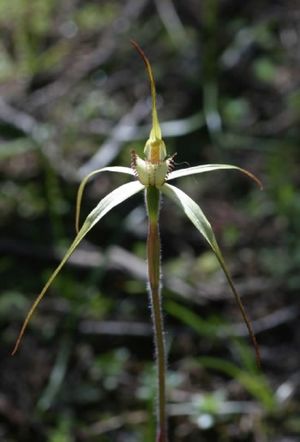Sand-hill spider orchid facts for kids
Quick facts for kids Sand-hill spider orchid |
|
|---|---|
 |
|
| Conservation status | |
| Scientific classification | |
| Genus: |
Caladenia
|
| Species: |
arenaria
|
| Synonyms | |
|
|
The sand-hill spider orchid (Caladenia arenaria) is a special plant. It belongs to the orchid family. This orchid only grows in New South Wales, Australia. It's a ground orchid, meaning it grows in the soil. It has one fuzzy leaf and pretty white or pale yellow flowers. The tips of its flowers are often maroon.
This orchid used to be found in many places. Now, it is much rarer. Only about 2,000 plants are left. They grow in just five spots in the Riverina area. Because it is so rare, it is called an "Endangered" species.
Contents
What Does the Sand-Hill Spider Orchid Look Like?
The sand-hill spider orchid is a plant that lives for many years. It grows from a special underground part called a tuber. This tuber is replaced with a new one every year.
In late autumn or early winter, a long, thin leaf grows. It is about 15 centimeters (6 inches) long. The leaf is reddish at its base.
Its Unique Flowers
This orchid usually has one flower, but sometimes two. The flowers are pale yellow or creamy-white. They grow on a hairy stem up to 40 centimeters (16 inches) tall.
The top part of the flower (dorsal sepal) and the side parts (lateral sepals and petals) can be up to 80 millimeters (3 inches) long. They often hang down a little. These parts narrow into thin, reddish, thread-like ends.
The orchid has a special lower petal called a labellum. It looks like an egg or a heart. It's about 18 millimeters (0.7 inches) long and 10 millimeters (0.4 inches) wide. The labellum has small teeth along its edges. These teeth get smaller towards the front. In the middle of the labellum, there are four to six rows of bumps. These bumps look like tiny golf club heads. The sand-hill spider orchid blooms from late August to November.
How Was This Orchid Named?
The sand-hill spider orchid was first officially described in 1882. A scientist named Robert FitzGerald wrote about it. He published his description in his book, Australian Orchids.
The scientific name arenaria comes from a Latin word. It means "sandy." This name fits well because the orchid often grows in sandy areas.
Where Does the Sand-Hill Spider Orchid Live?
This orchid likes to grow in certain types of forests. It is found in sclerophyll forests and on sandhills. You can often spot it growing under cypress pine trees.
In the past, this orchid was found over a large area. This area stretched about 500 kilometers (310 miles). It went from Deniliquin to Yass and Mudgee. Today, it is only found in five specific places. These locations are between Urana and Narrandera.
Why Is This Orchid Endangered?
The sand-hill spider orchid is listed as "Endangered." This means it is at high risk of disappearing forever. Both New South Wales law and Australian federal law protect it.
As mentioned, only about 2,000 plants are known to exist. They are spread across five small groups. The biggest dangers to this orchid are:
- Weeds: Other plants can grow too close and take away space and nutrients.
- Grazing: Animals eating the plants can harm them.
- Hybridisation: This happens when the sand-hill spider orchid mixes with other orchid types. This can make its unique features disappear.
Protecting these few remaining plants is very important. This helps ensure the sand-hill spider orchid can survive for future generations.


